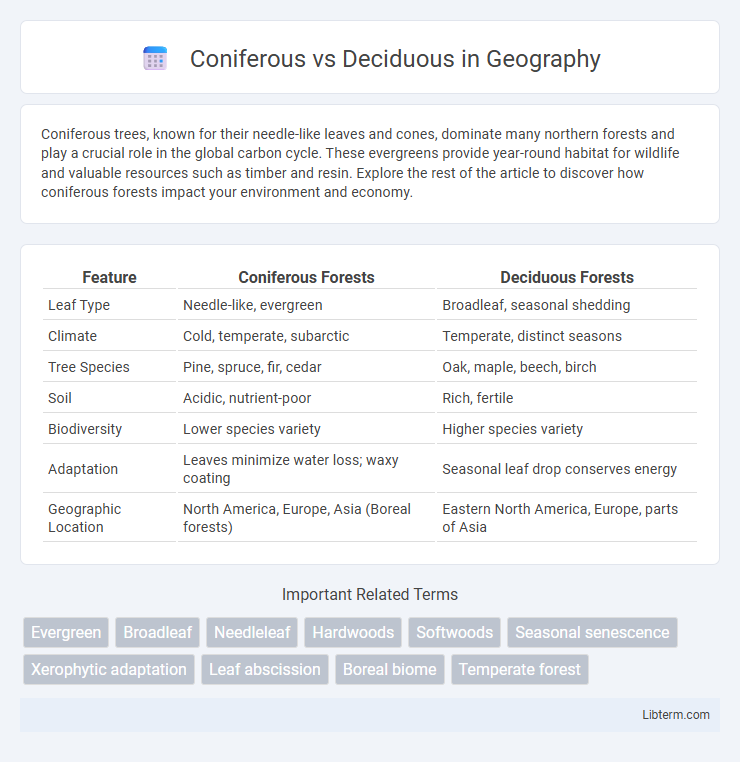Coniferous trees, known for their needle-like leaves and cones, dominate many northern forests and play a crucial role in the global carbon cycle. These evergreens provide year-round habitat for wildlife and valuable resources such as timber and resin. Explore the rest of the article to discover how coniferous forests impact your environment and economy.
Table of Comparison
| Feature | Coniferous Forests | Deciduous Forests |
|---|---|---|
| Leaf Type | Needle-like, evergreen | Broadleaf, seasonal shedding |
| Climate | Cold, temperate, subarctic | Temperate, distinct seasons |
| Tree Species | Pine, spruce, fir, cedar | Oak, maple, beech, birch |
| Soil | Acidic, nutrient-poor | Rich, fertile |
| Biodiversity | Lower species variety | Higher species variety |
| Adaptation | Leaves minimize water loss; waxy coating | Seasonal leaf drop conserves energy |
| Geographic Location | North America, Europe, Asia (Boreal forests) | Eastern North America, Europe, parts of Asia |
Introduction to Coniferous and Deciduous Trees
Coniferous trees, predominantly evergreen, feature needle-like leaves and produce cones for seed dispersal, thriving in colder climates and acidic soils. Deciduous trees shed their broad leaves seasonally to conserve water and energy, adapting efficiently to temperate regions with distinct seasonal changes. Understanding these differences is crucial for forestry management, ecological studies, and landscaping decisions.
Key Differences in Leaf Structure
Coniferous trees have needle-like or scale-like leaves coated with a thick, waxy cuticle to reduce water loss, allowing them to thrive in cold or dry environments. Deciduous trees possess broad, flat leaves with a large surface area and thin cuticle, optimized for efficient photosynthesis during the growing season. These structural differences reflect adaptations to their respective climates, with conifers maintaining leaves year-round and deciduous trees shedding leaves annually to conserve resources.
Climate and Geographic Distribution
Coniferous forests predominantly thrive in colder climates with long winters and short summers, commonly found in the northern hemisphere's boreal regions such as Canada, Russia, and Scandinavia. Deciduous forests are typically located in temperate zones with moderate rainfall and distinct seasonal changes, including eastern North America, Europe, and parts of East Asia. Geographic distribution of coniferous trees aligns with higher latitudes and elevations, whereas deciduous trees flourish in areas with milder winters and richer soils.
Growth Patterns and Lifespan
Coniferous trees generally exhibit slower growth rates but have longer lifespans, often exceeding several centuries, due to their needle-like leaves and evergreen nature that conserve water and nutrients. Deciduous trees grow faster, shedding leaves seasonally to optimize photosynthesis and energy use, with lifespans typically ranging from 50 to 150 years depending on species and environmental conditions. These distinct growth patterns and longevity reflect adaptations to climate, soil, and ecological niches.
Seasonal Changes: Evergreen vs. Deciduous
Coniferous trees, primarily evergreen, retain their needles year-round, enabling continuous photosynthesis even in winter, while deciduous trees shed their leaves in autumn to conserve water and energy during colder months. This seasonal leaf drop in deciduous species reduces transpiration and prevents damage from snow accumulation. Evergreen conifers adapt to seasonal changes by having needle-like leaves with a thick waxy coating, minimizing water loss and allowing survival in diverse climates, including harsh winter conditions.
Ecological Roles and Benefits
Coniferous forests play a crucial role in carbon sequestration and provide year-round habitat for diverse wildlife species, supporting ecosystem stability. Deciduous forests contribute to nutrient cycling by shedding leaves seasonally, enriching soil fertility and promoting biodiversity. Both forest types regulate water cycles and prevent soil erosion, enhancing environmental resilience.
Common Examples of Coniferous Trees
Common examples of coniferous trees include pine (Pinus), spruce (Picea), fir (Abies), cedar (Cedrus), and larch (Larix), all characterized by needle-like leaves and cone-bearing reproduction. These trees are typically evergreen, retaining their foliage year-round and thriving in colder climates with acidic, well-drained soils. Unlike deciduous trees that shed leaves seasonally, conifers have a waxy coating on needles to minimize water loss and withstand harsh winter conditions.
Popular Deciduous Tree Species
Popular deciduous tree species such as oak (Quercus), maple (Acer), and birch (Betula) are widely recognized for their broad leaves that change color and fall off annually. These trees play a crucial role in temperate ecosystems by supporting diverse wildlife and enhancing soil health through nutrient cycling. Their adaptability to various climates and landscapes makes them favored choices for urban planting and natural forests.
Uses in Landscaping and Timber Industry
Coniferous trees, such as pines and spruces, are prized in landscaping for their year-round greenery and ability to provide privacy screens and windbreaks. Their dense, resinous wood is highly valued in the timber industry for construction, paper production, and furniture making due to its strength and resistance to decay. In contrast, deciduous trees like oaks and maples offer seasonal color changes and shade in landscaping, while their hardwood is preferred for high-quality flooring, cabinetry, and veneer.
Environmental Impact and Conservation
Coniferous forests, predominantly composed of evergreen trees like pines and spruce, play a crucial role in carbon sequestration, storing significant amounts of carbon and mitigating climate change. Deciduous forests, with species such as oaks and maples, support higher biodiversity and nutrient cycling, benefiting soil health and ecosystem resilience. Conservation efforts target both forest types to preserve their unique ecological functions and address deforestation impacts on carbon storage and habitat loss.
Coniferous Infographic

 libterm.com
libterm.com